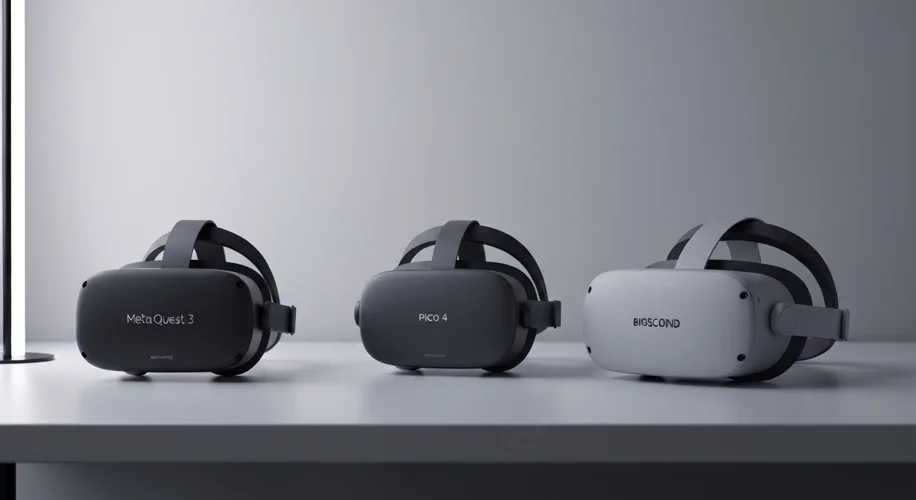Alright, let’s talk VR. If you’re even remotely into tech, you’ve probably been eyeing the latest headsets. The virtual world is evolving fast, and picking the right hardware can feel like a quest in itself. Today, I want to break down some of the hottest contenders for 2025: the Meta Quest 3 and its sibling the Quest 3S, Sony’s PSVR2, the Pico 4 Ultra, and the ultra-niche Bigscreen Beyond.
Quest 3 & Quest 3S: The All-Arounders
The Quest 3 has been a solid pick for a while now, offering a great balance of standalone VR and PCVR. Its mixed-reality capabilities are pretty impressive, letting you blend virtual elements with your real surroundings. The Quest 3S, rumored to be a slightly more budget-friendly version, is likely to offer a similar experience, perhaps with some compromises on display resolution or comfort features. Both are fantastic if you want a no-fuss entry into VR, or if you’re looking for a solid wireless PCVR experience without needing a beast of a gaming rig.
- Performance: Great for standalone VR and good for PCVR, especially with its wireless streaming options.
- Price: Generally mid-range, with the 3S expected to be even more accessible.
- Use Cases: Gaming, social VR, mixed reality apps, fitness.
- PCVR Requirements: More forgiving than some dedicated PCVR headsets. A decent gaming PC will do.
PSVR2: Console VR’s King?
Sony’s PlayStation VR2 is a powerhouse, but it’s locked into the PlayStation ecosystem. If you’re a PS5 owner, this is your premium VR option. The eye-tracking and haptic feedback in the controllers and headset are seriously next-level, making experiences incredibly immersive. The downside? You’re limited to PS5-exclusive VR titles, and the library, while growing, isn’t as vast as what you can access on PC.
- Performance: Excellent, with advanced tracking and haptics.
- Price: Premium, tied to the PS5 console.
- Use Cases: Console-based VR gaming, cinematic VR experiences.
- PCVR Requirements: N/A – strictly console.
Pico 4 Ultra: The Sleeper Hit?
The Pico 4 Ultra often gets overlooked, but it’s a strong competitor, especially in terms of clarity and comfort. It boasts a higher resolution per eye than the Quest 3, making visuals sharper. It also offers a slightly wider field of view. Like the Quest, it can function as a standalone device but also excels at PCVR, often praised for its wireless streaming capabilities. It’s a great option if you’re looking for PCVR without being tied to a specific ecosystem and want that edge in visual fidelity.
- Performance: Strong, particularly in visual clarity and wireless PCVR.
- Price: Competitive with the Quest 3.
- Use Cases: PCVR gaming, general VR experiences.
- PCVR Requirements: Similar to the Quest 3; a capable gaming PC is needed for the best experience.
Bigscreen Beyond: The Minimalist Marvel
This one is for the hardcore PCVR enthusiasts. The Bigscreen Beyond is ridiculously lightweight and custom-fitted to your face using a 3D scan. It offers incredible micro-OLED displays with pancake lenses for unmatched clarity and a super-wide field of view. But here’s the catch: it requires significant PC power, has no built-in audio (you’ll need your own headphones), and is essentially a display-only headset – you’ll need base stations and controllers too. It’s the ultimate headset if you prioritize visual fidelity and comfort above all else and have the PC to back it up.
- Performance: Unbeatable visual clarity and FOV for PCVR.
- Price: High-end, and you need to factor in additional accessories (base stations, controllers).
- Use Cases: High-fidelity PCVR gaming, simulations.
- PCVR Requirements: Extremely demanding. You’ll need a top-tier gaming PC.
So, Which One for You?
If you want an all-arounder that does standalone and PCVR well, the Quest 3 or Quest 3S are your go-tos. For the best console VR experience, PSVR2 is the only real choice if you own a PS5. If sharp visuals for PCVR are your priority and you want great wireless streaming, the Pico 4 Ultra is worth a serious look. And if you have a beast of a PC and crave the absolute best visual experience in VR, the Bigscreen Beyond is in a league of its own, albeit with more setup.
Ultimately, the best headset depends on your budget, your existing hardware, and what you want to do in VR. Happy hunting!

